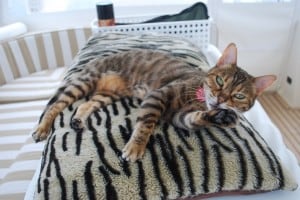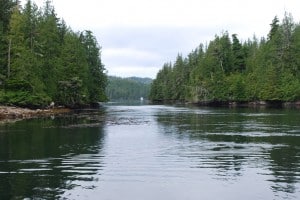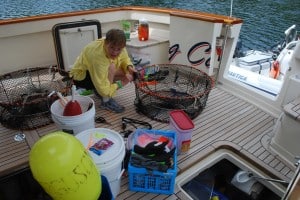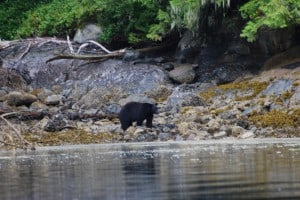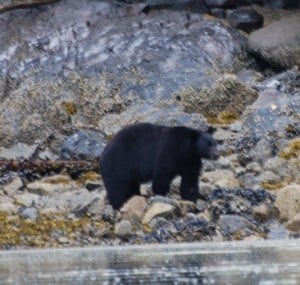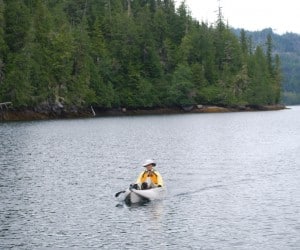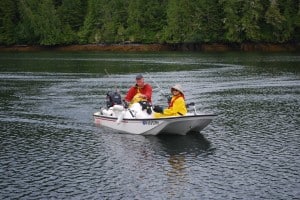It’s three months later than planned, but it’s nice to finally have some water under our bums. It’s even nicer to be anchored in a quiet lagoon as I write this, without another boat in sight except our good friends Steve and Shirley on Couverden. We’re out of cell phone range, no internet access – and not being inundated with London Summer Olympics updates or the latest machinations in the never-ending political races.
(Remember, you can click on any photo to enlarge. Also don’t forget that the formatting of this blog entry is better – and the captions line up with the photos – when you read it online at www.ronf-flyingcolours.com – click on this link to go there.)
A bit of update on Flying Colours’ arrival in Port McNeill. Turns out, the batteries in my SPOT didn’t go dead after all. It was pointed out by our friends, Jim and Christie Caldwell (Nordic Tug 42, NOETA), that when the SPOT is set on automatic tracking it stops after 24 hours in case it was left on accidentally. By the time I found this out, Flying Colours was close enough to Port McNeill to not worry about it.
At 11 o’clock last Thursday morning, Dana called to say they had just pulled into Port McNeill, having overnighted at Farewell Harbour, about two hours south of Port McNeill. On Wednesday afternoon, they hit high winds coming up the last 30 miles of Johnstone Strait, and coupled with the late start on the first morning, were behind Mike’s planned schedule by about three hours. Upon arrival, and after doing some cleanup on Flying Colours and fixing several things that required maintenance, Mike and Dana flew to Vancouver on Friday morning, and then hopped an airporter bus to take them across the border to Bellingham Airport where Dana’s husband picked them up.
Meanwhile on Friday, Kap and I finished up our last-minute architect and builder meetings, took a few glances at the new house construction, delivered Gator to Camp Kelly (Kelly’s Creature Comforts in Bonney Lake), and got ready for our Saturday morning Kenmore Air flight to Port McNeill.
Up at 5AM, everything was going well . . . that is, until it was time to get ZuZu into her Sherpa bag for the flight. ZuZu has an unerring perceptiveness about when we’re leaving on a trip. She goes to ground the minute she senses she might be going with us, and her ability to hide is amazing. Usually we try ahead of time to closet her in a room she can’t get out of, but she fooled us and hid somewhere in the lower floor family room where there are dozens of boxes and stuff stored for our move into the new house. We searched and searched with no luck. Finally, we heard a small meow and thought we’d pinpointed her. It was followed by a low growl on the other side of the room. We looked everywhere, but no ZuZu. Kap thought she pulled one on us, sneaking up the stairway to the main floor when we were bent over looking under something. Sure enough, she was hiding under the living room sofa, and howled when we pulled her out and put her in the Sherpa. She only made us 20 minutes late, and luckily there weren’t any delays on the drive to Bothell and the Kenmore Air Terminal.
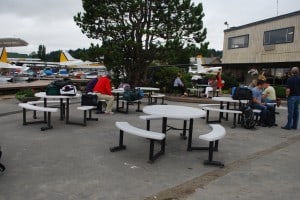
Kenmore Air is the only airline I know of where the departure "gates" are outdoor picnic tables. We were told to wait for our flight at Table 6.
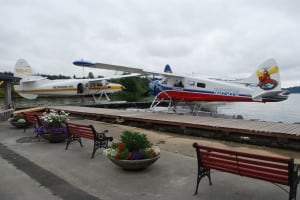
Our aircraft is the single-engine turboprop deHavilland Otter on the left. Kenmore Air has a good sense of humor - the Beaver on the right has the image of Bowinkle and Rockie on the tail.
Kenmore Air is pretty strict on baggage allowances – each passenger gets only 25 pounds, including hand carry bags. ZuZu was checked in at 9 pounds (seven plus her Sherpa bag), and my briefcase with PC and iPad and all the other electronic glimp I carry was 11 pounds – so that didn’t leave much weight allowance for anything else. Luckily we had loaded all of our clothes, cat food and kitty litter, and all of our provisioning aboard Flying Colours the previous weekend. I think we were 2-3 pounds overweight, and they cut us some slack on that, so check-in was OK. As usual, ZuZu was telling everyone within earshot that she didn’t want to be there, so the whole terminal knew we were carrying a cat.
Luckily, our aircraft was a deHavilland Otter, a 10-passenger turboprop that’s far less noisy than the smaller, but big-radial reciprocating engine deHavilland Beaver. Kap packs her pilot headphones to protect her ears on Kenmore Air flights and I wear the plug-in foam ear protectors, but there’s nothing we can do for poor ZuZu – she just has to tough it out for the several hour flight.
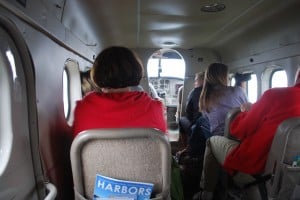
The deHavilland Otter is a 10-passenger aircraft, including the co-pilot's seat. Kap and I always ask for the rear two seats, as it gives us the area between our seats for ZuZu or Gator to ride. It also gives us about 5' of legroom.
We had an almost full flight – only one empty seat in the back and the co-pilot’s seat empty. When we’re traveling with a pet, we always ask for the two rear seats, as it gives us legroom that’s equal to the width of the passenger doors (I can stretch my legs out and still not touch the seat in front of me), whereas the four single-seat-on-each-side rows in front of us have less legroom than in Cattle Class on a commercial airliner. In the aisle between us, we stowed the Sherpa bag to keep an eye on ZuZu.
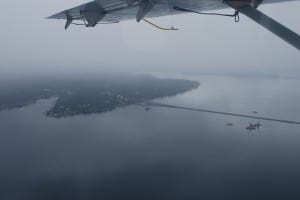
On our climb out to the south over Lake Washington, the clouds were low. Ahead is the 520 Floating Bridge, with several barges at the eastern highrise where they are laying the pilings and anchor points for the new replacement bridge. Our house is on Clyde Hill, back from the shoreline by about a mile and right about at the left edge of the photo.
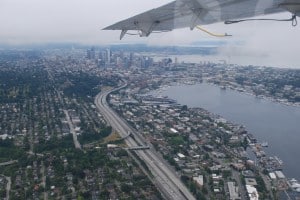
We're over I-5 and approaching Lake Union ahead. Downtown Seattle is to the south and just below the wingtip.
We departed the Kenmore Air terminal at the north end of Lake Washington at 8:40AM, and climbed out south over the lake for noise abatement. Flying low due to low clouds, our pilot then turned west at the Montlake Cut that joins Lake Union to Lake Washington, then across the north end of Lake Union to follow the Ship Canal out to the Ballard Locks. Once past the locks, we turned north and maintained an altitude of about 500’ along the east side of Puget Sound. Our destination was Nanaimo, about an hour and a half away, where we would land to clear Canadian Customs.
At Nanaimo we flew to the north of the city along the east side of Protection Island, then made a sweeping turn to the left for our approach and water landing in front of the B.C. Ferry terminal. It’s a short taxi from there to the Kenmore Air dock that’s shared with Seair Seaplanes.
Our plane was the first of five Kenmore flights to arrive in quick succession, and by the time the two Canadian Customs agents were checking our travel documents on the dock, every inch of the dock was taken up with arriving float planes. Every Kenmore Air flight bound for Canada clears Customs in Nanaimo, and from there they fan out to the dozen or so scheduled destinations they fly to. Most of the passengers are either heading for fishing resorts along the B.C. coast, or like us, flying up to their boat or the boat of a family or friend.
Customs was quickly cleared, including a check of ZuZu’s shot records, and while fuel was pumped aboard our plane we went up to the small terminal building to use the restroom. Within 15 minutes of our arrival, we were once again on board and took off to the north for our 1:15 minute second leg.
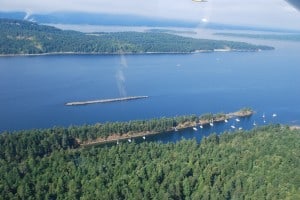
We passed Wallace Island on the way north from Nanaimo. It's a favorite anchoring spot, with upwards of 20 sailboats and powerboats anchored here. The boats with their stern to shore are "stern-tied" - where you anchor the bow, then run a polypropylene line from the stern to shore, wrap it around a tree, then back out to the stern. That way, you stay put no matter what the current is doing, and boats can be anchored close together. Our feeling is, if you have to stern tie, the place is too crowded, but sometimes you don't have a choice.
Five of our passengers were heading for the first stop, Pierre’s at Echo Bay Resort, and three of us were going on to Port McNeill. Looking out the left side window, I could see that we crossed over the Strait of Georgia, then north past the east side of Cortes Island when we approached the Desolation Sound area. That’s when we hit even lower clouds – clouds that I knew were below nearby mountaintop height. We were flying into and out of small clouds at our altitude, and the pilot was obviously having more difficulty staying in clear air. Having flown directly to Echo Bay several times on flights to and from the Broughton’s, I became a bit alarmed, knowing that the usual route was over the top of several mountains along the way. My hope was that he’d continue to follow the waterways and wouldn’t find himself boxed into a canyon that he couldn’t get out of (this is how a lot of pilots die). Being a really young guy too, I also hoped he was experienced enough in flying to Echo Bay that he could find his way on a route that wasn’t normal. Every Kenmore Air float plane has a GPS – looks like a small Garmin unit mounted on the dash – and I figured he was probably relying on that.
Within a few minutes, we were over a broad channel that could only be Johnstone Strait, and I could clearly see the unusual shape of Helmcken Island close in under the left wing. Just ahead and on the west side of the Strait was the tiny fishing village of Salmon Bay. The clouds were higher now, and it was comforting to get my bearings again.
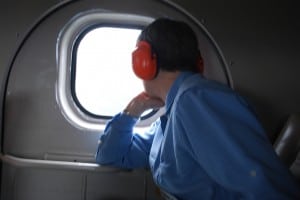
Kap is watching the scenery go by. With her pilot headphones she's able to keep the noise level to a manageable level.
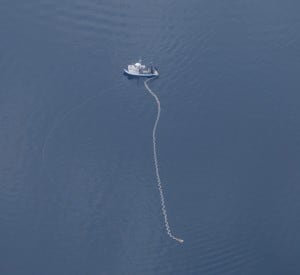
Below us on Johnstone Strait, I spied a commercial purse seiner with his net out. The white squiggly line in the center of the photo is a line of floats on the surface. Attached to it is the net - which you can faintly see in a loop to the left of it. Fish pile up in front of the net, and when it's time, the main boat sends out its "little boat" to the tip of the float line, and towing it in a circular motion back to the main boat they create a "purse" that traps the fish in the net.
As we passed West Cracoft Island, cloud base was high enough that we turned eastward, crossing over the island to follow Beware Passage northward. The landscape was dotted with dozens of small islands that scatter along Retreat Passage, and then we turned east to make our way into Echo Bay.
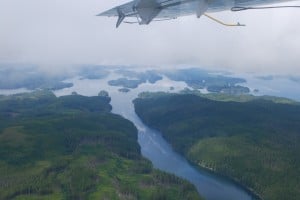
We're over the Broughton Archipelago, flying up a passage that will take us to Pierre's Resort at Echo Bay.
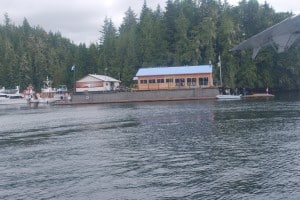
We've landed at Pierre's and taxiing into the floatplane dock. The resort's general store and new banquet building sit atop the Lake Washington Floating Bridge section that was towed up here many years ago.
Our turnaround time at Pierre’s Resort was no more than five minutes, and with ZuZu meowing loudly we took off again for the hour flight to Port McNeill. Visibility was good now, and no problem with low clouds, and the remainder of the flight was a non-event.
As we taxied into Port McNeill we could see Flying Colours at the dock, moored directly across from Couverden. By the time we stepped off the plane, Steve and Shirley were there to greet us. It felt like we were home.
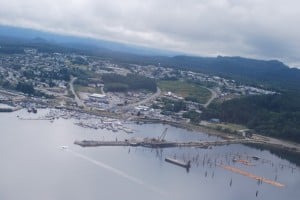
On the downwind leg before final approach to Port McNeill. The Fuel Dock Marina where Flying Colours is moored is to the left of center. The town of about 2,000 population is spread out from the shoreline. The large buildings in the center are a shopping center that contains a couple of restaurants, and a grocery store that's good for provisioning. The breakwater in the foreground is a staging area for log booms that are formed up here.
After settling our stuff onto Flying Colours – and most importantly, getting a litter box in the guest head set up for ZuZu – we headed for the local Market Place grocery store to lay in the fresh provisions we’d need for up to two weeks at anchor. We purchased our B.C. fishing licenses, and made plans with Steve and Shirley to get an early morning start to our favorite prawning grounds.
Awake at 5AM on Sunday morning, we checked out everything we could on Flying Colours so that hopefully she’d be seaworthy. One more trip to the grocery store for a few items we’d forgotten, and then it was time to leave our moorage and head to the other side of the marina to the fuel dock.
The diesel fill-up bill was more than a bit of a shock – C$2,957 for 2,263 liters of fuel (or US$ 2,934 for 598 gallons – which is $4.91/gal). It was obvious that Mike Johnson drove the boat hard in getting from Anacortes to Port McNeill in slightly more than two days – and I hadn’t stopped to figured out what the fuel bill would be. We’d have burned 3/4ths of that if we’d been at the helm ourselves, and getting to Port McNeill would have taken as much as a week the way we normally make the trip, so it’s still a good deal when you’re short on time.
The cruise to Booker Lagoon was planned for 2½ hours, and because of the unexpected amount of fuel we had to take on, we were almost a half hour late leaving. With the narrow shallow passage into Booker Lagoon, arriving within 10-15 minutes on either side of slack is critical. We put the pedal to the metal (actually harder than Mike had on the trip north), and when we arrived at the mouth of Booker Lagoon, it was as close to slack tide as could be. We slid through the passage without problem, Couverden ahead of us, and anchored about 200’ apart in the west finger of the lagoon. We were the only two boats in the entire lagoon, and without really believing it, we hoped it would remain that way.
Within two hours of arrival we had our prawn pots down for the first time. Two hours after that, we pulled them and had our best-ever load of prawns – 108 across two pots – and they were almost all larger than last years’ catch. (Our in-hand limit is 800 total for our two licenses, so we figured at this rate we’d have our limit in 3-4 days if we pulled our pots at least twice a day.)
Our first night at anchor was worth the wait. In the absolutely calm waters, we BBQ’d some steaks, watched a DVD while we quaffed lots of B.C. red wine, and then settled in for a nice sleep in the sheltered lagoon.
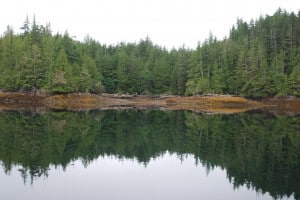
I never get tired of the early morning first light. We're at low tide, and with the absolutely calm waters it's hard to tell if the photo is right side up or not.
Monday, we pulled our pots three times, at 7AM, 1PM, and 6PM, for a total of 279 more prawns. During the day, I did the usual chore of peeling yesterday’s prawns, and the memory quickly came back how the razor-sharp shells and spiny daggers of these little critters prick thousands of tiny surface cuts and tear my thumbnail on one hand loose from the skin as I work to peel back the shell. It’s all worth it, though, if we can eat prawns from these crystal clear waters that lets us stay away from the imported prawns from Indonesia and Thailand that are so tainted with who knows what.
As we returned from the morning pull, Steve and Shirley were in Couverden’s cockpit, pointing to the shore. Less than 100’ away, a large black bear was foraging on the rocks at low tide, most likely getting a breakfast of mussels. I grabbed my camera from Flying Colours, and in the dinghy headed closer to shore to see if she (yes, she looked like a female, but I didn’t get close enough to tell for sure) would stay put for some good close-up shots. To my surprise, she took no notice of me at all, and from 50’ off the shore I snapped about a hundred photos.
That evening we tasted our first fresh prawns – a wonderful dinner of Flying Colours scampi.
Tuesday, similar results, but getting a bit lazy we only pulled our pots twice, for a total of 194 prawns. That afternoon for cocktail hour we feasted on about 100 “peel and eat” prawns that Steve cooked in the shell that morning. Couverden is famous for their secret cocktail sauce – called White Lightning – made with wasabi, horseradish, a splash of gin, Italian seasoning, and catsup.
Wednesday was our last full day at Booker Lagoon, and in a light rain at 8:30AM, we headed out for our first pot pull. Things seemed pretty routine by now, but as I started the pot puller the strain on the line seemed unusually heavy. That normally means a large starfish has gotten into a pot, which also means a small catch, as prawns don’t like being in a pot with a starfish. This time, though, the pull was unusually heavy right from the start, and with an extra 100’ of line down, it should just be the weight of the line until you get that first 100’ pulled up. Something was wrong.
By the time I had about 100’ pulled up, the tension on the line was so tight that the pot puller motor was straining, the dinghy was listing dangerously to the side I was pulling on, and the line was so tight in my hands that I could barely hold onto it. After letting the line back out and pulling it in two more times, we finally concluded our line was most likely wrapped around something on the bottom. If we couldn’t free it, there was nothing to do but cut the line and lose our pots – which meant the end of our prawning for the year.
Shirley and Steve saw we were having difficulty, so after pulling their pots they motored over. Always the couple with ideas, they tied our line to a cleat on the bow of their dinghy and then backed away in the direction we believed the pots to be in the water below. The bow of their dinghy dipped under the strain of the line, and we figured either our line would break or it would rip the cleat out of their dinghy. Neither happened, though, and after a lot of strain they appeared to be pulling our pots free.
We moved over to them, transferred the line over to our pot puller and hauled it up from the bottom. It was heavier than I’ve ever felt it. As our pots broke the surface, we could see what had happened. Our line had apparently wrapped around a batch of wide leaf seaweed on the bottom, and the only way to free it was to actually pull it up from the bottom. Barnacles from its roots came with it, and added about 100 lbs to what we were pulling up – and when you’re pulling heavy aluminum pots and netting, a load of shrimp, plus all that seaweed, it’s really heavy!
Nevertheless, that first pull plus another one in the afternoon netted us another 224 prawns for the day. That put us within striking distance of our limit, and we decided to put the pots down for one more overnight soak and early next morning head back to Port McNeill. We had toilet and black water tank problems on Flying Colours that needed sorting out, and Port McNeill was the closest place to look into it. Without a proper shakedown cruise this year (actually, this long distance cruise was our shakedown), there wasn’t any way to resolve the niggling problems that always crop up on a boat from year to year.
The slack tide for Thursday morning was 9AM, and if we didn’t make it out of the lagoon on that slack, we’d have to wait for the afternoon slack at 3PM – which would put us into Port McNeill later than we’d like. Low water slack was in the morning and high water slack in the afternoon, which if we went in the morning meant we’d have to transit through the meandering 30’ wide passage with only 30’ of water beneath our keel. Careful maneuvering would get us through, but it would be a bit of a white-knuckle ride.
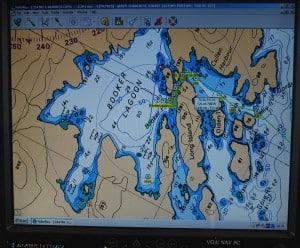
Our chart plotter image of Booker Lagoon as we motored towards the passage out of the lagoon. Flying Colours is the green boat symbol in the center of the image.
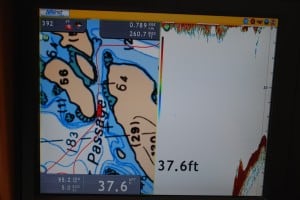
The chart plotter shows us entering the passage out of Booker Lagoon. The depth sounder at right shows we have 37.6' under our keel.
We decided go for it. We’d get out early – 6AM – to pull our pots one last time, tidy up everything, get the dinghy stored on board, pull up our anchor from the muddy bottom, and be at the mouth of the lagoon right at 9AM. It would be a rushed morning, but otherwise, we’d have little choice but to wait out another day, and our holding tank wasn’t up to the task.
Our final pull on Thursday morning brought in 79 prawns, and subtracting out the ones we ate on board, it put us right at our limit. Happy with our catch – not quite The Deadliest Catch, but a good catch in any case – we departed Booker Lagoon. With Kap at the helm and me studying the zoomed-in navigation screen, we safely exited through the tiny Booker Lagoon Passage and into the outer Cullen Harbour. Once we were in open water, Kap got us up to cruising speed as I settled in at the salon table to peel the previous day’s prawn catch.
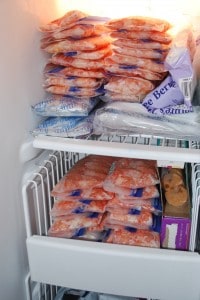
Our stash of 800 prawns are all peeled, shrink-wrapped, and safely frozen in the freezer aboard Flying Colours.
By noon we were back at Port McNeill – which now feels like home to us. We’re back in cell phone range and Internet access, so I’m able to post this latest Cruising On Flying Colours blog.
Stay tuned.
Ron

